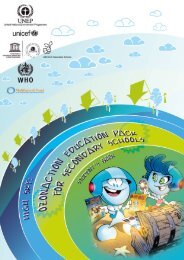Chapter 2. Progress towards the EFA goals - Unesco
Chapter 2. Progress towards the EFA goals - Unesco
Chapter 2. Progress towards the EFA goals - Unesco
Create successful ePaper yourself
Turn your PDF publications into a flip-book with our unique Google optimized e-Paper software.
PROGRESS TOWARDS THE <strong>EFA</strong> GOALS<br />
Youth and adult literacy<br />
numeracy skills, and <strong>the</strong>reby <strong>the</strong> development of<br />
active citizenship, improved health and livelihoods<br />
and gender equality’ (Global Campaign for<br />
Education and ActionAid International, 2005, p.13).<br />
A combination of <strong>the</strong>se two broad definitions<br />
captures <strong>the</strong> reality of illiteracy as a condition<br />
that denies people opportunity.<br />
The condition affects much of <strong>the</strong> world’s youth<br />
and adult population, especially women in<br />
developing countries. While all regions are<br />
affected, a relatively small group of countries<br />
with large populations dominates <strong>the</strong> global<br />
illiteracy headcount.<br />
The illiteracy scourge continues<br />
An estimated 759 million adults – around 16%<br />
of <strong>the</strong> world’s population aged 15 and over – lack<br />
<strong>the</strong> basic reading, writing and numeracy skills<br />
needed in everyday life (Table <strong>2.</strong>6). More than half<br />
live in South and West Asia, and ano<strong>the</strong>r one-fifth<br />
in sub-Saharan Africa. Reflecting <strong>the</strong> legacy of<br />
gender disparity in education, almost two in every<br />
three adult illiterates are female (see annex,<br />
Statistical Table 2).<br />
Measured in aggregate terms, adult illiterates<br />
are heavily concentrated in a small group of largepopulation<br />
countries (Figure <strong>2.</strong>29). Just twenty<br />
countries account for around 80% of global illiterates,<br />
with Bangladesh, China, India and Pakistan making<br />
up over half <strong>the</strong> total. The data in this section<br />
highlight <strong>the</strong> concentration of illiteracy in developing<br />
countries. This should not deflect attention from<br />
<strong>the</strong> serious problems in rich countries, where large<br />
pockets of illiteracy contribute to wider patterns<br />
of social and economic marginalization (Box <strong>2.</strong>19).<br />
Aggregate figures mask differences in <strong>the</strong><br />
incidence of illiteracy. Both South and West Asia,<br />
and sub-Saharan Africa have high illiteracy rates,<br />
with more than one in three adults affected in both<br />
regions (Table <strong>2.</strong>6). In sub-Saharan Africa, twelve<br />
countries have illiteracy rates in excess of 50%;<br />
among <strong>the</strong>se, in Burkina Faso, Guinea, Mali and<br />
<strong>the</strong> Niger, more than 70% of <strong>the</strong> adult population<br />
is illiterate (Figure <strong>2.</strong>30). In <strong>the</strong> Arab States, <strong>the</strong><br />
proportion is nearly one-third. Gender disparities are<br />
a major contributor to <strong>the</strong> high adult illiteracy rates<br />
in all three regions (see annex, Statistical Table 2).<br />
For instance:<br />
Table <strong>2.</strong>6: Adult (15 and over) illiteracy rates and numbers,<br />
by region, 2000–2007 1<br />
World<br />
Illiteracy<br />
rates<br />
(%) 2 Illiterates<br />
(millions)<br />
16 759<br />
Figure <strong>2.</strong>29: Adult illiteracy is heavily concentrated<br />
in a small group of large-population countries<br />
Adult (15 and over) illiterates (millions), top ten countries<br />
Rest of <strong>the</strong> world, 218<br />
Developing countries<br />
Developed countries<br />
Countries in transition<br />
Sub-Saharan Africa<br />
Arab States<br />
Central Asia<br />
East Asia and <strong>the</strong> Pacific<br />
East Asia<br />
Pacific<br />
South and West Asia<br />
Latin America and <strong>the</strong> Caribbean<br />
Caribbean<br />
Latin America<br />
North America and Western Europe<br />
Central and Eastern Europe<br />
20 752<br />
0.7 5<br />
0.6 1<br />
38 153<br />
29 58<br />
1 0.7<br />
7 108<br />
7 106<br />
7 2<br />
36 391<br />
9 36<br />
25 3<br />
9 33<br />
0.6 4<br />
2 8<br />
Morocco, 10<br />
Indonesia, 13<br />
Brazil, 14<br />
Egypt, 17<br />
Nigeria, 23<br />
Ethiopia, 27<br />
Pakistan, 47<br />
Bangladesh, 49<br />
China, 71<br />
India, 270<br />
About 759 million<br />
adults lack <strong>the</strong><br />
basic reading,<br />
writing and<br />
numeracy skills<br />
needed in<br />
everyday life<br />
Notes: The population used to generate <strong>the</strong> number of illiterates is from <strong>the</strong> United Nations Population Division estimates (2006 revision).<br />
For countries with national observed literacy data, <strong>the</strong> population used corresponds to <strong>the</strong> year of <strong>the</strong> census or survey.<br />
1. Data are for <strong>the</strong> most recent year available during <strong>the</strong> period specified. See <strong>the</strong> web version of <strong>the</strong> introduction to <strong>the</strong> statistical tables for a broader<br />
explanation of national literacy definitions, assessment methods, and sources and years of data.<br />
<strong>2.</strong> The illiteracy rate is calculated as 100 minus <strong>the</strong> literacy rate.<br />
Source: Annex, Statistical Table <strong>2.</strong><br />
95
















